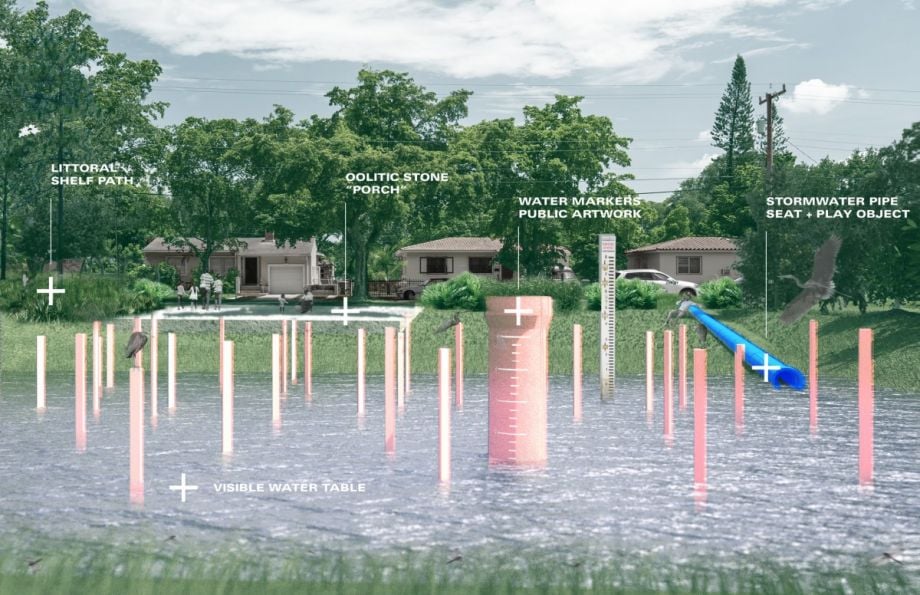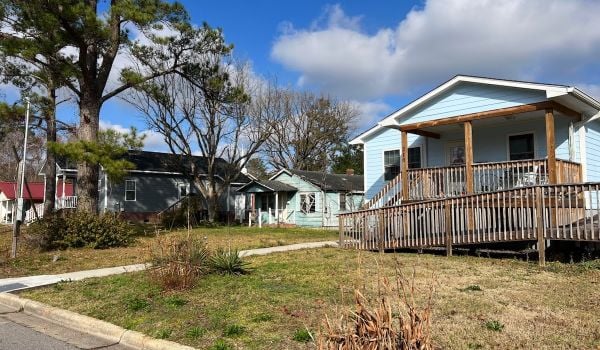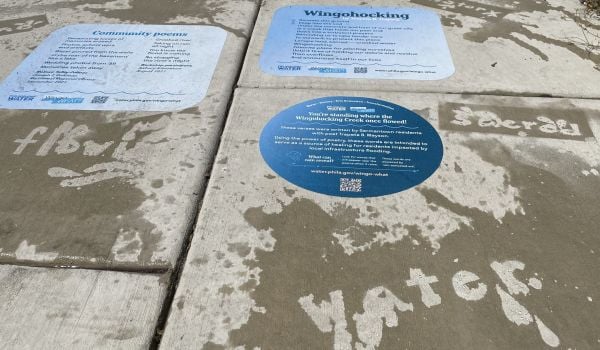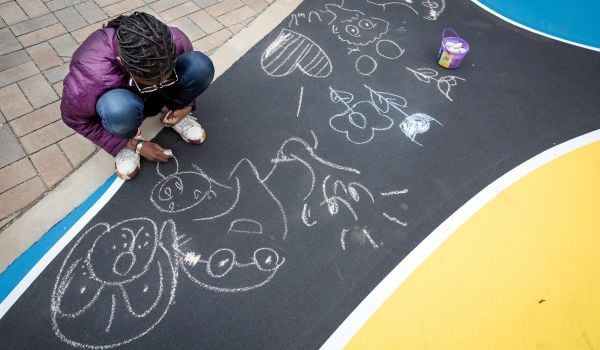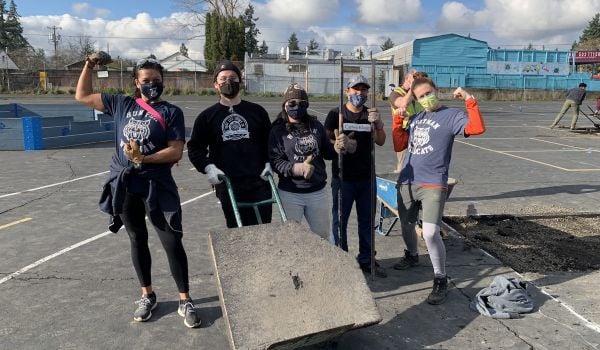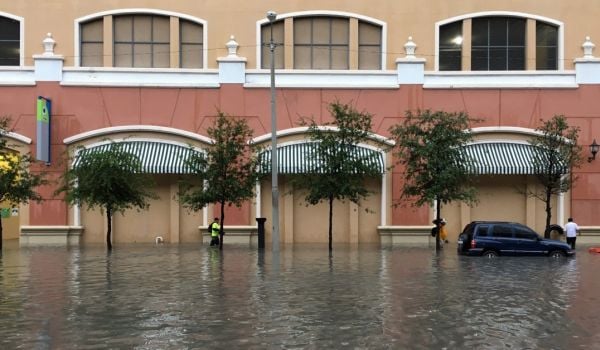EDITOR’S NOTE: Next City is a partner in #CoveringClimateNow, a global collaboration of more than 250 news outlets to strengthen coverage of the climate story. Read Next City’s other stories for this initiative here.
Isaac Stein is not a fan of the term “repetitive loss property,” a FEMA designation for land that regularly floods. “It views the property as a sinkhole, and puts it in this space that is a vacancy or detriment to the community,” he says.
When landscape architect Stein and urban designer Maggie Tsang founded urban design firm Department Design Office last year, one of their goals was to rethink the potential of properties vulnerable to climate change. This July, the Cambridge, Massachusetts-based firm earned the opportunity to help North Miami take on that challenge.
Department Design Office is the winner of Keeping Current: Repetitive Loss Properties, a competition by Van Alen Institute and City of North Miami inviting designers to reimagine public uses of the city’s current and future so-called repetitive loss properties. The competition focused on a single vacant lot in the middle of a block lined with low-rise houses.
The idea, according to Van Alen, is “to promote climate-consciousness, reinvigorate an underused communal area, and reduce the cost of flood insurance, in hopes that other cities will also benefit.” Department Design Office’s winning proposal, titled Good Neighbor, will transform the lot into an open green space with public seating and interactive stormwater infrastructure meant to accommodate and respond to flooding.
“Their proposal made water visible, while also providing a serene landscape people could enjoy,” says Kokei Otosi, project manager for the larger Keeping Current Initiative, which engages residents of Greater Miami on sea level rise.

Van Alen turned its focus to North Miami as “it’s a smaller, less resourced city,” according to Otosi. “Local council members were advocating for climate initiatives but didn’t necessarily have the funding or means to implement those.”
The partnership and ensuing competition was a way to demonstrate climate solutions implemented on a smaller scale. The winner of the competition will also contribute to a larger master planning for the city and its flood-prone lots.
Van Alen brought Miami-based Urban Impact Lab to lead community engagement. “This is a really diverse community, with Latino, Haitian and African-American communities,” says Marta Viciedo, founding partner of Urban Impact Lab. “It was door-to-door engagement, speaking to residents along the block where the project will be implemented.”
Early engagement found that residents were well aware of regular flooding at the site and the vulnerability of their block. “Residents really care about the beauty of the site, the natural elements,” Viciedo says. “They want to make sure whatever is built is respectful of their space on the block, but are not suggesting any walls or fencing be built.”
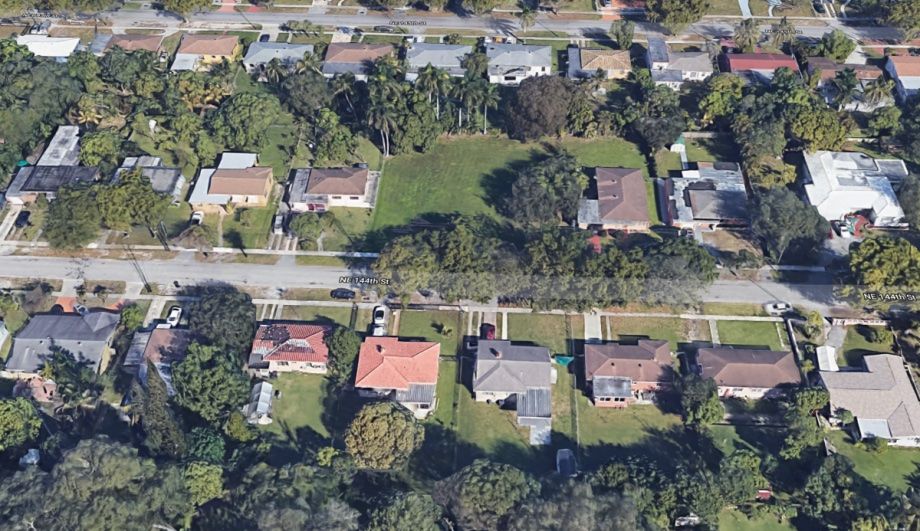
The vacant lot where Good Neighbor will be built. (Imagery © Google, Map data © 2019)
Department Design Office’s proposal addressed critical concerns from community discussions: protecting their properties and creating useful public space. Through the piping and basin system, stormwater will flow into a water retention pool and decrease the amount of flooding on nearby properties. With physical markers registering changes in the water table, the retention pool will make flood water visible to members of the community, increasing local awareness of the risk of flooding and sea level rise.
Department Design Office is collaborating with Miami artist Adler Guerrier on the artwork that will register changes in water level, as well as the hazard mitigation startup Forerunner.
“Typically stormwater infrastructure is buried — out of sight, out of mind — and you only know about it when it doesn’t work,” says Stein. “Our objective was to expose everything so people are more aware and have visible markers to understand what is happening.”
This visible infrastructure will be surrounded by diverse native plants — selected to highlight different ecosystems sacrificed due to development — as well as walking paths.
Department Design Office will now work with the city, Van Alen, Urban Impact Lab and community residents to fine-tune the design. The firm is fundraising to supplement $80,000 awarded by the competition. Ultimately, the goal is to unveil the site this December.
In early 2020, Van Alen will present a larger master plan developed by Department Design Office to North Miami council members. “It’s trying to provide the city with a guidebook for how to acquire more financial resources, to acquire more repetitive loss properties, and also provide a roadmap for how to repurpose those properties,” says Otosi.
Department Design Office’s pilot design will be one of a handful included in the master plan. “They’re recommendations for how to repurpose these sites based on community feedback, community demographics, and how individuals like to spend their time,” Otosi says.
Members of the team believe that acting on community engagement is crucial as climate change increasingly shapes certain neighborhoods. “We’re still doing a lot of talking in South Florida, not doing enough direct action and making these projects real,” says Viciedo. “As this is implemented and its success is shown, this is something that can be replicated quite quickly, not just for the city of North Miami, but the entire region.”

Emily Nonko is a social justice and solutions-oriented reporter based in Brooklyn, New York. She covers a range of topics for Next City, including arts and culture, housing, movement building and transit.
Follow Emily .(JavaScript must be enabled to view this email address)

